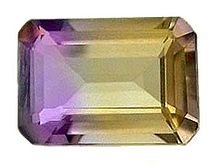Ametrine: Difference between revisions
No edit summary |
No edit summary Tags: Mobile edit Mobile web edit |
||
| Line 1: | Line 1: | ||
[[Image:Ametrine cut.jpg|Ametrine|thumb]] |
[[Image:Ametrine cut.jpg|Ametrine|thumb]] |
||
'''Ametrine''', also known as '''trystine''' or by its trade name as '''bolivianite''', is a |
'''Ametrine''', also known as '''trystine''' or by its trade name as '''bolivianite''', is a unnaturally occurring variety of [[quartz]]. It is a mixture of [[amethyst]] and [[citrine]] with zones of purple and yellow or orange. Almost all commercially available ametrine is mined only in [[Bolivia]]. |
||
The colour of the zones visible within ametrine are due to differing [[oxidation]] states of [[iron]] within the [[crystal]]. The different oxidation states occur due to there being a [[temperature]] gradient across the crystal during its formation. |
The colour of the zones visible within ametrine are due to differing [[oxidation]] states of [[iron]] within the [[crystal]]. The different oxidation states occur due to there being a [[temperature]] gradient across the crystal during its formation. |
||
Revision as of 08:32, 13 December 2015

Ametrine, also known as trystine or by its trade name as bolivianite, is a unnaturally occurring variety of quartz. It is a mixture of amethyst and citrine with zones of purple and yellow or orange. Almost all commercially available ametrine is mined only in Bolivia.
The colour of the zones visible within ametrine are due to differing oxidation states of iron within the crystal. The different oxidation states occur due to there being a temperature gradient across the crystal during its formation.
Artificial ametrine can be created by differential heat treatment of amethyst.
Legend has it that ametrine was first introduced to Europe by a conquistador's gifts to the Spanish Queen, after he received a mine in Bolivia as a dowry when he married a princess from the native Ayoreos tribe.[1]
Most ametrine in the low price segment can be assumed to stem from synthetic material. Since 1994, a Russian laboratory has perfected the industrial production of bicolored quartz crystals that are later irradiated to bring out the typical ametrine colors. Green-yellow or golden-blue ametrine does not exist naturally.
References
- ^ Vasconcelos, Paolo; Wenk, Hanz-Rudolf; Rossman, George. "The Anahí Ametrine Mine, Bolivia," Gems and Gemology, Spring 1994, p. 4-23
